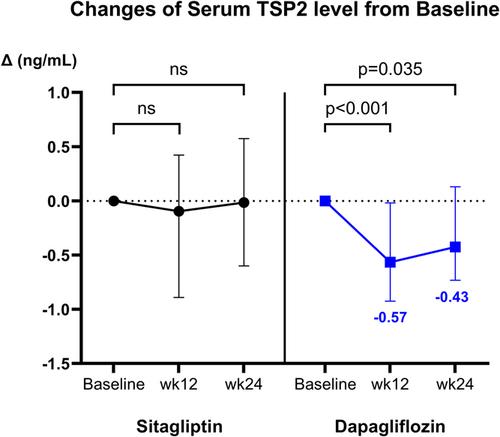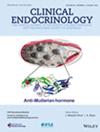Serum thrombospondin-2 level changes with liver stiffness improvement in patients with type 2 diabetes
Abstract
Objective
Baseline circulating thrombospondin-2 (TSP2) level was identified as a potential novel hepatic fibrosis biomarker that associates with development and progression of hepatic fibrosis in patients with nonalcoholic fatty liver disease and type 2 diabetes. Here, we investigated whether circulating TSP2 levels changed with improvement in liver stiffness (LS), which reflects liver fibrosis on transient elastography.
Design
Serum TSP2 levels were measured in participants from a randomized, open-label intervention study, at baseline and after 24-weeks treatment of either dapagliflozin 10 mg (N = 30) or sitagliptin 100 mg daily (N = 30). Vibration-controlled transient elastography was performed to evaluate the severity of hepatic fibrosis and steatosis using LS and controlled attenuation parameter (CAP), respectively.
Patients and Measurements
Among all 60 participants with similar clinical characteristics at baseline (mean HbA1c 8.9%, CAP 289 dB/m and LS 5.8 kPa), despite similar HbA1c lowering, treatment with dapagliflozin, but not sitagliptin, led to significant improvements in body weight (BW) (p = .012), CAP (p = .015) and LS (p = .011) after 24 weeks.
Results
Serum TSP2 level decreased significantly from baseline in dapagliflozin-treated participants (p = .035), whereas no significant change was observed with sitagliptin. In correlation analysis, change in serum TSP2 levels only positively correlated with change in LS (r = .487, p = .006), but not with changes in BW, CAP or HbA1c after dapagliflozin treatment.
Conclusions
Serum TSP2 level decreased with LS after dapagliflozin treatment, and was independent of improvements in BW, glycemic control and hepatic steatosis, further supporting the potential of serum TSP2 level as a novel hepatic fibrosis biomarker in type 2 diabetes.


 求助内容:
求助内容: 应助结果提醒方式:
应助结果提醒方式:


